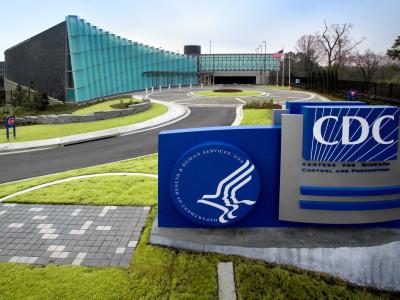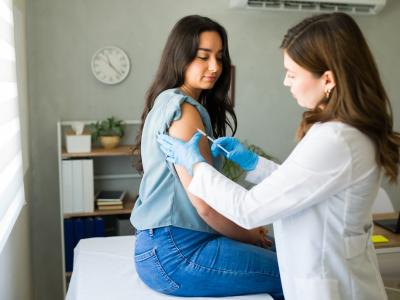Our weekly wrap-up of antimicrobial stewardship & antimicrobial resistance scans
MRSA hospital return tied to extensive antibiotic exposure, C diff infection
Secondary analysis of patients from a postdischarge decolonization trial of methicillin-resistant Staphylococcus aureus (MRSA) carriers found that re-hospitalization for MRSA was associated with extensive exposure to non-MRSA antibiotics and Clostridioides difficile infection (CDI), researchers reported today in Infection Control & Hospital Epidemiology.
The CLEAR (Changing Lives to Eradicate Antibiotic Resistance) Trial, conducted from March 2011 through April 2014, found that a postdischarge decolonization regimen (5 days of mupirocin plus chlorhexidine bathing and mouthwash) among MRSA infected or colonized adult inpatients reduced MRSA infection by 30% in the year following hospital discharge, compared with those who received only education about MRSA.
For the secondary analysis, researchers from University of California Irvine School of Medicine identified trial participants who were re-hospitalized owing to a new MRSA infection following trial enrollment. Their aim was to quantify antibiotics given to those patients and any hospital-onset CDI risk.
The researchers identified 123 trial participants with 154 hospitalizations for MRSA infection. The most common type of MRSA infection included skin and other soft-tissue infection (37%), bone and joint infection (30%), and pneumonia (14%). Fifty-six patients required intensive care unit stays, and 10 patients died. Overall, 25 hospitalizations involved only anti-MRSA antibiotics, and 129 hospitalizations involved empiric antibiotic therapy targeting more than MRSA, with a total of 7.9 days of therapy of non-MRSA antibiotics. Six cases of CDI occurred among the 154 hospitalizations, for an incidence of 3.9%, which exceeds the national incidence rate of hospital-onset CDI (0.3%)
The study authors say the findings highlight the importance of effective MRSA prevention strategies, such as postdischarge decolonization.
"Our study highlights the value of eradicating MDROs [multidrug-resistant organisms], such as MRSA, to prevent acquisition of or infection with another antibiotic-associated pathogen such as C. difficile," they wrote.
Apr 16 Infect Control Hosp Epidemiol abstract
Feb 14, 2019, CIDRAP News story on the CLEAR Trial
ED stewardship intervention tied to reduced prescribing for viral infections
Originally published by CIDRAP News Apr 14
A pilot trial conducted at two emergency departments (EDs) found that audit and feedback with peer-to-peer comparisons reduced antibiotic prescribing for viral acute respiratory infections (ARIs) but not overall antibiotic use, researchers reported today in Open Forum Infectious Diseases.
The quasi-experimental study used an interrupted time-series design and a matched-pair non-equivalent control group to evaluate the impact of the pilot intervention, which consisted of an initial one-on-one educational meeting with each willing ED clinician and individual clinician feedback at baseline and via a quarterly email. The feedback to clinicians focused on the frequency of antibiotic prescribing for uncomplicated ARIs and for prescribing for all patient visits.
The researchers compared the total antimicrobial prescribing rate at two Veterans Affairs Medical Center EDs that implemented the intervention with two control EDs. An exploratory analysis measured antibiotic prescribing for uncomplicated ARIs and reviewed charts to assess guideline-concordant management for six common infections.
The study enrolled 27 of 31 eligible clinicians at the two EDs, who acknowledged the receipt of 33.3% of feedback emails. In the baseline and intervention periods, intervention sites had 28,016 and 23,164 patient visits, respectively, compared with 33,077 and 28,835 at the control EDs.
Analysis of the primary outcome during the intervention period showed a non-significant absolute reduction of 1% in the monthly total antibiotic prescribing rate at the intervention sites compared with the control sites (incidence rate ratio, 0.99; 95% confidence interval, 0.98 to 1.01).
The exploratory analysis, however, found that antibiotic prescribing for uncomplicated ARIs at the intervention sites declined from 68.6% to 42.4% between the baseline and intervention periods, and guideline-concordant management at the intervention sites improved from 52.1% to 72.5%. Those improvements were not seen at the control sites.
"Future stewardship studies on audit-and-feedback in EDs should incorporate additional strategies, such as local champions, to improve the adoption and sustainability of the intervention," the authors wrote. "Future studies could also evaluate the perceived acceptability of the feedback and optimal methods for delivering feedback, including for infections other than ARIs."
Apr 14 Open Forum Infect Dis abstract
Swiss biotech receives funding for novel antibiotic development
Originally published by CIDRAP News Apr 14
Swiss biotech company BioVersys today announced a financing deal with the European Investment Bank (EIB) for up to €20 million (US $23.9 million) to support development of novel antibiotics for multidrug-resistant infections.
The venture loan will facilitate development of two products in BioVersys' pipeline: BV100, which is being studied for treatment of ventilator-associated bacterial pneumonia caused by carbapenem-resistant Acinetobacter Baumannii, and BVL-GSK098, a small molecule being tested for multidrug-resistant tuberculosis infections. Both drugs are in phase 1 clinical trials.
"There have been no new classes of antibiotics on the market for decades," EIB Vice-President Thomas Ostros said in a BioVersys press release. "This comes at an enormous cost for people and our societies at large. If we do not manage to curb AMR [antimicrobial resistance], it will not only kill thousands of people every year, but it will also drive millions into poverty."
The loan is financed under the Infectious Diseases Finance Facility, set up as part of a European Union initiative aimed at securing Europe's global competitiveness.
Apr 14 BioVersys press release
Antibiotic prescribing fell in British Columbia during pandemic
Originally published by CIDRAP News Apr 13
Overall and respiratory tract infection (RTI)-specific antibiotic prescribing fell significantly in British Columbia during the first few months of the COVID-19 pandemic, according to a study today in Open Forum Infectious Diseases.
Researchers from the British Columbia Centre for Disease Control and the University of British Columbia collected data on antibiotic prescriptions, diagnoses, and physician office visits in the Canadian province from January 2016 to Jul 21, 2020. They calculated monthly prescription rates stratified by age-group, sex, profession, and diagnosis type, and looked at the monthly prescription rate as a moving average over time. They also conducted an interrupted time series analysis to determine if there was a significant change in prescription rates after March 2020.
The results showed that moving average of monthly prescribing rates from January to June 2020 were below the minimum of the pre-pandemic years' moving averages. In addition, researchers observed a more than 30% reduction in monthly prescription rates in April, May, and July of 2020 compared with the same months in 2019. The interrupted time series analysis showed overall monthly prescription rates experienced a significant level change of -12.79 after COVID-19 restrictions were put into place in March 2020, with the greatest level change (-18.02) observed in children ages 1 through 4.
When looking at prescriptions matched to diagnoses, the researchers found that RTI-associated prescriptions decreased significantly during April to July 2020 compared with the same 4 months during the pre-pandemic years, and the interrupted time series analysis found an estimated level change of -5.94 in RTI-associated monthly prescription rates after March 2020. Monthly prescription rates for amoxicillin, amoxicillin and enzyme inhibitors, azithromycin, clarithromycin, and sulfamethoxazole during January to July 2020 all fell compared with the same period in 2019.
The study authors speculate that the implementation of COVID-19 restrictions in the province, the subsequent reduction in opportunities for infectious disease transmission, and a shift to telemedicine all played role in the abrupt decline in antibiotic prescribing.
"These radical changes in tandem likely led to a multitude of overlapping potential scenarios, all of which resulted in the decreased use of antibiotics in BC," they wrote.
Apr 13 Open Forum Infect Dis abstract
USAID addresses AMR in animal production in Africa, Asia
Originally published by CIDRAP News Apr 13
The US Agency for International Development (USAID) yesterday announced the launch of a project to address emerging infectious diseases and antimicrobial resistance (AMR) in animal production in Africa and Asia.
The Transformational Strategies for Farm Output Risk Mitigation (TRANSFORM) project is a 5-year, $33 million effort that will engage companies involved in animal production and marketing systems and partner with country governments to develop, test, and scale innovative solutions to sustainably improve animal health, strengthen animal production systems in animal agriculture value chains, and enhance global health security. USAID says the public/private partnership will explore strategies to improve safety and production practices, develop and implement antimicrobial stewardship policies across the industry, and establish a comprehensive animal health surveillance and data analytics platform to reduce infectious disease and AMR.
"USAID understands that human health is inextricably linked with the health of animals and the environment, and TRANSFORM represents a new and innovative way to protect human health by improving policies and practices related to animal production," the agency said in a press release.
TRANSFORM will be implemented by a consortium that includes Cargill, Ausvet, Heifer International, and the International Poultry Council.
Apr 12 USAID press release
Audit and feedback, prior approval may reduce fluoroquinolone use
Originally published by CIDRAP News Apr 12
A study of Veterans Affairs (VA) hospitals found that prospective audit and feedback (PAF) and prior-approval strategies focused on fluoroquinolone use were associated with lower fluoroquinolone prescribing rates, US researchers reported today in Infection Control & Hospital Epidemiology.
Despite multiple safety warnings on fluoroquinolones from the Food and Drug Administration and concerns about antibiotic resistance and Clostridioides difficile infection, the antibiotics are frequently prescribed in US healthcare settings. In the two-part study, conducted at 15 VA acute-care medical centers, researchers surveyed antimicrobial stewardship program (ASP) leaders about the local implementation and acceptability of different strategies to improve fluoroquinolone prescribing, along with analysis of data on antibiotic administration at each hospital in 2017 and 2018. The researchers then compared fluoroquinolone days of therapy (DOT) per 1,000 days present (DP) for sites with and without PAF and/or prior approval.
The surveys showed that 9 of the 15 hospitals (60%) had PAF or prior-approval strategies for fluoroquinolones. Compared with sites using neither strategy, fluoroquinolone prescribing rates were lower for sites that implemented PAF and/or prior approval (64.4 DOT/1,000 PD vs 35.5 DOT/1,000 PD) and decreased from 2017 to 2018. That decrease occurred without a corresponding increase in advanced-generation cephalosporin prescribing, a common alternative.
Total antibiotic rates were 13% lower for sites with PAF and/or prior approval, but this difference did not reach statistical significance. In the hospitals where stewardship leaders reported that PAF and/or prior approval were "completely" accepted, fluoroquinolone prescribing rates were lower than at sites where it was "moderately" accepted (34.2 DOT/1,000 PD vs 48.6 DOT/1,000 PD).
Stewardship leaders also reported that clinical pathways and/or local guidelines (93%), prior approval (93%), order forms (80%), and infectious disease consults (73%) "would" or "may be" effective in improving fluoroquinolone use.
"Additional research should be conducted to provide further insight as to facilitators and barriers to implementing persuasive and restrictive strategies on the use of fluoroquinolones," the authors wrote. "In addition, appropriate antibiotic substitutes for these agents should be identified based on safety, local sensitivities, and as recommended in treatment guidelines."
Apr 12 Infect Control Hosp Epidemiol abstract
WHO issues report on AMR in water and the environment
Originally published by CIDRAP News Apr 12
A report released today by the World Health Organization (WHO) proposes actions for assessing and managing the risk to human health from AMR in water and the environment.
As a result of decades of use and overuse of antibiotics and other antimicrobial agents in human and animal medicine, antibiotic residues and their metabolites, drug-resistant bacteria, and AMR genes are common, widespread contaminants in water and the environment. But WHO guidelines for drinking water, recreational water, and use of wastewater and excreta in agriculture and aquaculture contain no specific advice on how to assess, manage, or minimize human exposure or the potential human health risks associated with the presence of these contaminants.
"Because the presence of antimicrobial-resistant bacteria and their AMR genes in water, wastewater, wastewater-irrigated foods, and aquacultural systems is now widely recognized, greater and more harmonized consideration of them as an environmental health hazard is needed," the authors note.
To better assess the risk for human exposure, the document from the WHO's Water, Sanitation and Hygiene (WASH) team calls for improved identification of drug-resistant bacteria and AMR genes in human and animal wastes, and more research into the movement of those bacteria and genes through the environment and the various pathways for human exposure. It also recommends developing approaches to estimate the health risks associated with exposure via routes such as ingestion, inhalation, skin and eye contact, and food.
To manage the risks, the WHO proposes developing systems for tracking and monitoring antibiotics, resistant bacteria, and AMR genes in water and the environment, identifying technologies that can minimize the presence of these contaminants in water, and implementing strategies to combat the widespread use and overuse of antibiotics in human and animal health.
The document also calls on the WHO to develop new guidance to inform and support efforts to control the presence of antibiotics and antimicrobial-resistant bacteria in human and animal waste and the environment and reduce or minimize human exposure.
Apr 12 WHO briefing note










